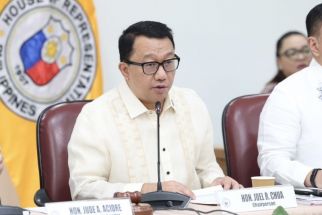Gringo proving hard to catch
April 25, 2006 | 12:00am
Hero, senator, soldier, rebel.
Now add this to the list: Most wanted man in the Philippines.
Gregorio Honasan, an icon of the 1986 people power revolt against Ferdinand Marcos, was twice elected to the Senate. Now, he has been on the run since February for allegedly plotting to overthrow President Arroyo.
Although his handsome face is well known throughout the country, he is proving hard to catch. Police have organized a nationwide manhunt, set up a telephone hotline and offered a reward of P5 million for information leading to his capture, but to no avail.
Authorities acknowledge that Honasan, commonly known as "Gringo,’ is receiving help from civilians and members of the military who support his cause. Friends of the former Army colonel say he has been stopped several times by police and soldiers, who let him go after they recognized him. A couple even saluted him.
"Gringo is a very slippery guy," acknowledged Justice Secretary Raul Gonzalez. "We acknowledge the fact that he has a substantial following among the ranks of the armed forces. People seem to believe in him."
Honasan’s status as a fugitive highlights the political turmoil of the Philippines, where Mrs. Arroyo has barely clung to power after her administration inadvertently released an embarrassing audio recording in which she ordered an official to make sure she won the 2004 election by one million votes.
With the President rejecting all calls for her resignation and her congressional supporters blocking impeachment, some of her adversaries turned to plotting a coup. Mrs. Arroyo got wind of the plot in February, days before it was to be implemented. She declared a state of national emergency, gave herself additional powers and ordered the arrest of the alleged ringleaders, including Honasan.
Authorities say the plot against Mrs. Arroyo included a plan to assassinate her. They allege that Honasan and other conspirators who are on the run are still plotting to take power.
"We are not really out of the woods yet," said Gonzalez, who also was named as an assassination target. "The ones who want to destabilize the administration are just hibernating."
Honasan, who got his nickname because of his pale skin, founded the Reform the Armed Forces Movement, or RAM, of like-minded rebellious officers in the 1980s. He proved to be a charismatic leader and recruiter and played a key part in Marcos’ ouster. He was later featured on People Power T-shirts showing him armed to the teeth.
But he was soon dissatisfied with Marcos’ successor, Corazon Aquino, and began plotting another coup. In all, he staged seven coup attempts against Aquino between 1987 and 1989, but never succeeded.
"He has a long string of failures unblemished by success," said one longtime associate who still considers himself a friend and spoke on condition of anonymity.
Honasan was captured in 1987 and imprisoned on a ship. It didn’t take long for him to convert his military guards to the cause and they all escaped together.
On the run during the late 1980s, he adopted various disguises, including shaving his well-known mustache and dressing as a nun, he recounted in a 2004 television interview.
On another occasion, he traveled by hearse while lying in a coffin.
"It was eerie, almost scary," he said in the interview with GMA- 7. "I worried that someone would nail the coffin shut."
Traveling one day by bus while dressed as a woman, Honasan found his fellow passengers staring and giggling at him, and he feared he had been recognized. But it turned out he had forgotten to shave that morning and his fellow passengers believed him to be a careless transvestite.
Police came so close to arresting him that he once had to hide in a sewer. Another time, he fled by climbing over a wall topped with razor wire. After he made it over, he saw blood streaming from his hand and realized he had cut off the ring finger on his right hand. He went back and found the digit but was unable to reach a surgeon in time to get it reattached.
Honasan and other rebel soldiers were granted amnesty by President Fidel Ramos in 1995. Honasan went to win election to the Senate and served the maximum two terms.
Honasan, never an Arroyo supporter, allegedly went back to his coup-plotting ways in 2003, when he inspired soldiers in Manila to seize a shopping mall and apartment building in a short-lived mutiny.
In an interview with the Los Angeles Times in October, Honasan said he was not personally interested in leading the Philippines. But he said the country needed a change, and that the President could be replaced by a transitional committee of respected citizens with the goal of restoring democracy.
"When we are ready, the opposition leader will surface," he said.
But Honasan has his detractors, even among his friends.
One former officer who asked not to be identified said Honasan’s role in plotting coups has diminished and that he has lost respect among some of his co-conspirators. Part of the reason is money.
Among some, the coup leader has become known as "Honasan, Inc." for his efforts to raise funds for Mrs. Arroyo’s ouster. In recent months, some contributors have questioned where the money has gone.
"Honasan has perfected the art of making money out of a coup," the former officer said. "If it’s about money, then it’s not a real coup."
— New York Times News Service
Now add this to the list: Most wanted man in the Philippines.
Gregorio Honasan, an icon of the 1986 people power revolt against Ferdinand Marcos, was twice elected to the Senate. Now, he has been on the run since February for allegedly plotting to overthrow President Arroyo.
Although his handsome face is well known throughout the country, he is proving hard to catch. Police have organized a nationwide manhunt, set up a telephone hotline and offered a reward of P5 million for information leading to his capture, but to no avail.
Authorities acknowledge that Honasan, commonly known as "Gringo,’ is receiving help from civilians and members of the military who support his cause. Friends of the former Army colonel say he has been stopped several times by police and soldiers, who let him go after they recognized him. A couple even saluted him.
"Gringo is a very slippery guy," acknowledged Justice Secretary Raul Gonzalez. "We acknowledge the fact that he has a substantial following among the ranks of the armed forces. People seem to believe in him."
Honasan’s status as a fugitive highlights the political turmoil of the Philippines, where Mrs. Arroyo has barely clung to power after her administration inadvertently released an embarrassing audio recording in which she ordered an official to make sure she won the 2004 election by one million votes.
With the President rejecting all calls for her resignation and her congressional supporters blocking impeachment, some of her adversaries turned to plotting a coup. Mrs. Arroyo got wind of the plot in February, days before it was to be implemented. She declared a state of national emergency, gave herself additional powers and ordered the arrest of the alleged ringleaders, including Honasan.
Authorities say the plot against Mrs. Arroyo included a plan to assassinate her. They allege that Honasan and other conspirators who are on the run are still plotting to take power.
"We are not really out of the woods yet," said Gonzalez, who also was named as an assassination target. "The ones who want to destabilize the administration are just hibernating."
Honasan, who got his nickname because of his pale skin, founded the Reform the Armed Forces Movement, or RAM, of like-minded rebellious officers in the 1980s. He proved to be a charismatic leader and recruiter and played a key part in Marcos’ ouster. He was later featured on People Power T-shirts showing him armed to the teeth.
But he was soon dissatisfied with Marcos’ successor, Corazon Aquino, and began plotting another coup. In all, he staged seven coup attempts against Aquino between 1987 and 1989, but never succeeded.
"He has a long string of failures unblemished by success," said one longtime associate who still considers himself a friend and spoke on condition of anonymity.
Honasan was captured in 1987 and imprisoned on a ship. It didn’t take long for him to convert his military guards to the cause and they all escaped together.
On the run during the late 1980s, he adopted various disguises, including shaving his well-known mustache and dressing as a nun, he recounted in a 2004 television interview.
On another occasion, he traveled by hearse while lying in a coffin.
"It was eerie, almost scary," he said in the interview with GMA- 7. "I worried that someone would nail the coffin shut."
Traveling one day by bus while dressed as a woman, Honasan found his fellow passengers staring and giggling at him, and he feared he had been recognized. But it turned out he had forgotten to shave that morning and his fellow passengers believed him to be a careless transvestite.
Police came so close to arresting him that he once had to hide in a sewer. Another time, he fled by climbing over a wall topped with razor wire. After he made it over, he saw blood streaming from his hand and realized he had cut off the ring finger on his right hand. He went back and found the digit but was unable to reach a surgeon in time to get it reattached.
Honasan and other rebel soldiers were granted amnesty by President Fidel Ramos in 1995. Honasan went to win election to the Senate and served the maximum two terms.
Honasan, never an Arroyo supporter, allegedly went back to his coup-plotting ways in 2003, when he inspired soldiers in Manila to seize a shopping mall and apartment building in a short-lived mutiny.
In an interview with the Los Angeles Times in October, Honasan said he was not personally interested in leading the Philippines. But he said the country needed a change, and that the President could be replaced by a transitional committee of respected citizens with the goal of restoring democracy.
"When we are ready, the opposition leader will surface," he said.
But Honasan has his detractors, even among his friends.
One former officer who asked not to be identified said Honasan’s role in plotting coups has diminished and that he has lost respect among some of his co-conspirators. Part of the reason is money.
Among some, the coup leader has become known as "Honasan, Inc." for his efforts to raise funds for Mrs. Arroyo’s ouster. In recent months, some contributors have questioned where the money has gone.
"Honasan has perfected the art of making money out of a coup," the former officer said. "If it’s about money, then it’s not a real coup."
— New York Times News Service
BrandSpace Articles
<
>
- Latest
- Trending
Trending
Latest
Trending
Latest
Recommended

































